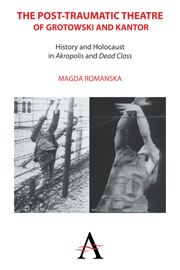 The Post-traumatic Theatre of Grotowski and Kantor
The Post-traumatic Theatre of Grotowski and Kantor from Part II - Our Memory: Kantor's Dead Class
Jan Kott once called Dead Class a form of Kaddish, the Jewish mourner's prayer. Jewish law requires that the Kaddish be recited by selected mourners for the first 11 months after the death of a loved one, and then on each anniversary of the death. The Kaddish is a mourning prayer recited in Aramaic that praises the greatness of God, asking him for peace for all. It never refers directly to that which it is about: death. In Hebrew and other Semitic languages, the name of God is written without vowels, as it was strictly forbidden to pronounce it. In mystical theology, the supreme experience of being, that is, the perfect name of God, is the experience of meaning of the gramma itself, “word that is written but not read” (Quere wela ketib). As Agamben explains it, “as the unnamable name of God, the gramma is the final and negative dimension of meaning, no longer an experience of language but language itself, that is, its taking place in the removal of voice.” According to Derrida, the sign stands in for the thing it signifies; by being there, the sign signifies the absence of the thing it designates. The sign thus is a pure negativity. It establishes its meaning on the basis of difference from other signs, other negativities. Thus, language is a play of negativities that negate themselves in relation to themselves, and which negate the very things they signify.
To save this book to your Kindle, first ensure [email protected] is added to your Approved Personal Document E-mail List under your Personal Document Settings on the Manage Your Content and Devices page of your Amazon account. Then enter the ‘name’ part of your Kindle email address below. Find out more about saving to your Kindle.
Note you can select to save to either the @free.kindle.com or @kindle.com variations. ‘@free.kindle.com’ emails are free but can only be saved to your device when it is connected to wi-fi. ‘@kindle.com’ emails can be delivered even when you are not connected to wi-fi, but note that service fees apply.
Find out more about the Kindle Personal Document Service.
To save content items to your account, please confirm that you agree to abide by our usage policies. If this is the first time you use this feature, you will be asked to authorise Cambridge Core to connect with your account. Find out more about saving content to Dropbox.
To save content items to your account, please confirm that you agree to abide by our usage policies. If this is the first time you use this feature, you will be asked to authorise Cambridge Core to connect with your account. Find out more about saving content to Google Drive.